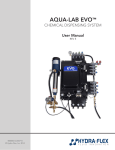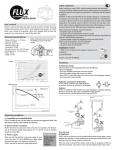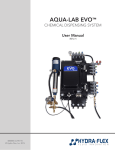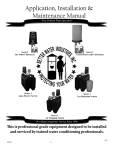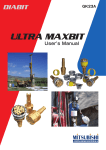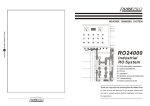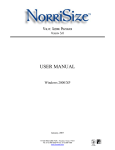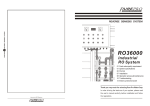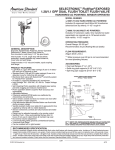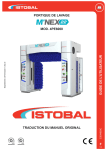Download Istobal User Manual - Hydra
Transcript
AQUA-LAB EVO™ Chemical Dispensing System Istobal User Manual REV B © Hydra-Flex Inc 2014 Table of Contents Contents Specifications .............................................................................................................................................. 1 Illustrations .................................................................................................................................................. 2 Principles of Operation................................................................................................................................ 4 Startup ......................................................................................................................................................... 5 Pump Priming Instructions ...................................................................................................................... 5 Istobal M22 / M24 Initial Set Up ................................................................................................................ 6 Optimizing the System ............................................................................................................................ 6 Chemical Usage Measuring .................................................................................................................... 7 Troubleshooting .......................................................................................................................................... 9 Injector Vacuum Check (for troubleshooting injectors) ......................................................................... 9 Injector Issues .......................................................................................................................................... 9 Air Operated Valve Replacement ......................................................................................................... 10 Pump Issues ........................................................................................................................................... 11 Pressure Regulator Issues ...................................................................................................................... 12 Flow / Arch Issues ................................................................................................................................. 12 Appendix ................................................................................................................................................... 13 Chemical Dilution Ratios…………………………………………………………………………….. 14 Injector Listing………………………………………………………………………………………..15 Replacement Parts List………………………………………………………………………………..16 Warranty………………………………………………………………………………………………17 © Hydra-Flex Inc 2014 Specifications 1. 2. 3. 4. 5. 6. 7. 8. 9. 10. Operating water pressure: 180- 200 psi - Do Not Operate Pump Above 225psi Pneumatics operating pressure: 80-100 psi – Do Not Operate Valves Above 100psi Maximum water source temperature 140° F Operating ambient temperature: 40-120° F Electrical supply a. 208/230 or 480 volts (3-phase) b. 2 hp pump 7.4 amps @ 230 volts or 3.7 amps @ 480 volts c. Overload Setting 8.0 @ 230 volts or 4.0 @ 480 volts Operate solenoid valves with 24VAC, 24VDC, 120VAC a. 3.5 watts per port Water supply a. 3/4” ID line pump feed b. Inlet pressure: 2-80 psi i. If pumps are fed from tank, water level must be 54” above pumps. Air supply a. 3/8” feed per system b. 20 CFM @ 80-100 psi supply Solution lines a. 3/8” ID poly lines for 3.25GPM and below b. ½” ID poly line for 3.25 to 5.5 GPM c. .63 ID poly line for 5.5 – 8 GPM Space requirements: a. 38”W x 44”H with pump assembly For additional support call: 952.808.3640 © Hydra-Flex Inc 2014 Page | 1 Illustrations H2O Inlet Pressure Gauge Air Actuated Hydra-Cannon Valve – 1-12 starting at the top left hand side and working clockwise. Air Solenoid Valves – 1-16 starting at the top left hand side and working clock-wise. Mounting Slots (2 top, 2 bottom) Air Pilot Solenoid Valves 1-4 Integrated Electrical Control Box Air Pilot Solenoid Valves 5-8 10 GPM Quick Change Pump Air Pilot Solenoid Valves 9-12 Primary Air Regulator Foaming Air Solenoid Valves 13-15 Inlet Water Selection Valve (Optional) Bypass/Pressure Regulator Foaming Air or Frost Protection Air Valves + Regulators (Optional) Wye Strainer Thermal Relief Valve Multi Conductor Three Phase Power to Pump Signal Cable © Hydra-Flex Inc 2014 Air Pilot Solenoid Valve 16 For Inlet Water Selector (optional) Three Phase Power In Page | 2 Diode Terminal Block Timer Contactor Integrated Motor Starter Power In Thermal Overload © Hydra-Flex Inc 2014 Page | 3 Principles of Operation The Aqua-Lab EVO was designed to meet the application requirements of the standard roll-over automatic car wash with an available pump room to store chemical and equipment. The system is set-up so that all that is required from the car wash controller is an output signal for each valve. The EVO electrical control box uses that signal to open both the 3.5 watt air solenoid valves and to start the pump. The standard 10 GPM pump produces up to 225 psi of pressure which is regulated down to 200psi by the bypass regulator. (The pump should never run above 225 psi.) The 200 psi water flows into the Hydra-Cannon manifold which is fitted with 12 air-actuated valves that are controlled by air solenoid valves. The water valves control the flow of water to each injector or flow-thru rinse fitting. The Chem-Flex injectors are color-coded based on the water flow needed for each individual application, and combine with color-coded chemical metering tips to proportion the precise chemical mix ratio. As water flows into the Chem-Flex injector, the velocity increases. As the velocity increases the pressure decreases creating a vacuum which allows the precise amount of chemical to be pulled into the chamber where it mixes with water. This precise chemical mixing, along with the proper nozzle, creates an optimal display in the wash bay. Optional components that are included with the Istobal EVO system include an inlet water selection valve, a foaming air wing, a system-protection pressure switch and the tri-foam manifold. The inlet water selection value is operated using an air solenoid valve. This valve allows the option of using two different water sources. The foaming air wing is used as a blow-out frost protection. When the temperature drops below a certain pre-set point, air is forced through the lines, clearing them of water or solution that could potentially freeze and cause damage. The pressure switch is supplied to ensure that if the pump is not getting pressure, a signal will be sent to the controller to shut the system down. The tri-foam manifold is a three position quick-connect manifold that fits into a single port to support triple foam or equivalent operations. © Hydra-Flex Inc 2014 Page | 4 Startup Pump Priming Instructions 1. Pull the pump outlet line at the manifold quick-connect. Open ball valve and direct toward a drain or container to remove the majority of the air from the pump until a steady stream of water is flowing (approx. 1 min). 2. Start the pump using a command from the controller. Ensure that pump rotation is correct as indicated by the arrow on the bottom of the pump and that 200 psi can be reached. o If pump cannot regulate to 200 psi. remove pump motor cover and look at shaft to confirm correct rotation 3. Start the pump and slowly open ball valve until it is wide open. Allow to run for 60 seconds to flush lines and then close valve. 4. Reconnect the high pressure line to the Hydra-Cannon Manifold and open valve. 5. Confirm that the pump can obtain 200 psi while firing solenoids and that the pump housing (stainless steel tube) is cool to the touch after a minute in operation. o If housing is hot or noisy then pump did not prime correctly. 6. If pump does not prime, repeat steps 3-5 7. Verify pump prime 24 hours after operation to ensure prime held. Pay close attention to the temperature of the pump housing (stainless steel area).If it starts getting hotter than the supply water or greater than 140°, then it is likely that the pump did not prime correctly which will cause damage to pumps. The motor housing (painted portion) will be hot during operation. © Hydra-Flex Inc 2014 Page | 5 Istobal M22 / M24 Initial Set Up Application Injector Nozzles Pre Spray / 2 step Shampoo 618098 – 3.25gpm 618086 – 2.25gpm 10x 0880, 4x 632.676 2x 0880, 10x 0680 Shampoo Rinse Flow Thru - 3000173 See shampoo White Foam 618086 – 2.25gpm As Shipped Triple Foam 3x 618070 – 1.5gpm each As Shipped Wax / Super Wax 618096 – 3.25gpm 2x 632.676, 2x0880 Horns Rinse Flow Thru - 3000173 See Wax Low Pressure Under Spray Flow Thru - 3000173 As Shipped CTA TBD TBD Bug Spray TBD TBD Optimizing the System Consistently achieve the desired cleaning and presentation/performance using the least amount of chemical and water Injectors vs. Metering Tips vs. Nozzles The key to optimizing the system is through trial and error. Don’t be afraid to try these steps to achieve your ideal performance. What do injectors do? o Increases or decreases the amount of water in the solution What do metering tips do? o Increases or decreases the amount of chemical in the solution What do nozzles do? o Determines the pattern and backpressure of the solution © Hydra-Flex Inc 2014 Page | 6 Application Optimization (repeat for each application) • • • • • • • Application too wet o Increase air o Reduce injector size (decreases water) o Increase metering tip (increases chemical) Application too dry o Decrease air o Increase injector size (increases water) o Decrease metering tip (decreases chemical) Nozzle sputters o Decrease air o Decrease nozzle(s) and/or size used on arch o Increase injector size (increases water) Too much chemical used o Decrease metering tip o Decrease metering tip and injector size (to maintain desired ratio) No chemical o Check vacuum of injector (see instructions on page 9) o Check foot valve o Check metering tip Nozzle fan pattern not filled o Reduce nozzle size o Increase injector size (increases water) Water not present at all nozzles on arch o Verify check valves are functioning o Verify nozzles are not plugged o Reduce number of nozzles o Reduce nozzle size o Increase injector size (increases water) Chemical Usage Measuring Verify titration of chemicals before proceeding 1. Setup lab scale with small bucket of chemical to be measured. 2. Put the suction line into the bucket. 3. Run the application being tested to “prime” the line. (All air bubbles must be removed for accuracy) 4. Record the Initial Weight from the scale. (Tarring the scale with weight on the scale can affect accuracy) 5. Run the application for 6 vehicles (or manually for the same it would be on for 6 vehicles). 6. Record the Final Weight from the scale. 7. Subtract the Initial Weight from the Final Weight to determine the weight of used product. 8. Divide this Used Weight by 6 to get a per car weight. 9. Divide the Per Car Weight in grams by the specific gravity of the chemical to determine the milliliters of chemical used per vehicle. 10. Repeat for each chemical application. © Hydra-Flex Inc 2014 Page | 7 Recommended Maintenance The recommended service and maintenance on the AQUA-LAB System are as follows. Monthly • Check air regulator • Check water filter and replace as needed (if installed) Semi-Annually • Check and replace injector metering tips • Check and clean wye strainer • Inspect and replace chemical lines as needed • Ensure lines are tightly secured to injector hose barbs, clip 1” off old hose as needed that was stretched by hose barb Annually • Clean water regulator • Inspect motor starter for corrosion, if identified order replacement/spare parts 1-3 Years • Inspect and replace injectors • Replace water valves • Replace main pressure regulator © Hydra-Flex Inc 2014 Page | 8 Troubleshooting Injector Vacuum Check (for troubleshooting injectors) 1. At the Chem-Flex injector, remove the chemical feed line from the injector hose barb. 2. Attach the tubing of the vacuum gauge to the Chem-Flex hose barb 3. With the pump(s) on, manually activate the chemical that is to be tested at the main car wash control cabinet. An injector that is working properly will have a reading greater than or equal to (≥) 20 in Hg 4. If injector is not functioning: a) Check metering tip for clogs (can be tested with no metering tip to ensure injector is performing) b) Try smaller injector (this will produce less flow and thus less backpressure) c) Remove a nozzle(s) at the arch, allowing water to free flow (this will reduce backpressure) 5. Repeat steps 2-4 for each chemical lane that a vacuum reading is needed for. 6. Once testing is complete, turn off the AQUA-LAB pump from the main car wash control cabinet. There is a variation of performance in the injectors that comes from slight variations in the dimensions of the parts and in assembly that are unavoidable. It is common to see the resultant vacuum range from 20 in Hg all the way up to 28. There is also variation in the through hole size on the meter tips from Dema (within their manufacturing tolerances). Using the same tip color from site to site is a good starting point. However with the potential for variation from part to part it is reasonable to still need to do some adjustments from there. Injector Issues Problem Potential Causes Solutions Injector is not drawing chemical – PASSES vacuum pressure check Clogged chemical feed Check chemical hose, foot valve, metering tip and hose barb for debris or clogs Too much back pressure on injector Clean or replace downstream check valves, increase nozzle size or quantity, use larger tubing, or use smaller flow injectors Blow compressed air through the chemical hose barb on the injector to remove debris Remove injector and blow out any debris with compressed air Replace injector Remove elbow at inlet to foam generator and remove nozzle Remove end fittings and retention rod. Clean out inlet holes to allow full flow. Ensure minimum 60 psi on primary air regulator, ensure valve receiving signal Remove injector and blow out debris with compressed air Check that the system has a supply of water Call Hydra-Flex and order composite version of injectors Clogged injector check valve Injector is not drawing chemical – FAILS vacuum pressure check Clogged injector nozzle Defective Injector Product Specific – Sonny’s Rain Bar Manifold Inlet Clogged (rare) Valve malfunction, valve not opening No Flow from injector Injector Stainless Steel disintegrating © Hydra-Flex Inc 2014 Clogged injector No water supply Strong Acid Page | 9 Air Operated Valve Replacement 1. Shut off the ball valve to Hydra-Cannon manifold 2. Disconnect air line from front of valve 3. Unscrew quick connect fitting by hand (DON’T LOSE BLACK WASHER) 4. Unscrew valve assembly from the Hydra-Cannon manifold 5. Screw new valve into manifold until hand tight and threaded pilot port is facing forward 6. Remove the cap from pilot port and thread in quick connect fitting to front of valve – Hand Tight ONLY 7. Push air line back into fitting 8. Open the ball valve to the Hydra-Cannon manifold Unscrew from manifold using this portion of valve © Hydra-Flex Inc 2014 Page | 10 Pump Issues Problem Potential Causes Solutions Pump Operates, but only delivering 100150 psi Incorrect Motor Rotation Reverse rotation by interchanging two leads Pump not Primed Missing 1 of 3 phases Inadequate water supply See Priming Instructions Wire according to diagram Check pressure on inlet side of pump to be sure positive pressure is maintained Replace with larger piping Make sure connections are tight Replace worn parts or entire pump, clean parts if required Make sure constant control voltage is supplied in car wash controller. Could be due to blown pump motor. Try to turn breaker back on or replace fuse. If breaker trips after trying to fire motor, motor is most likely burned out. Replace with new motor and pump. Replace motor starter contactor Adjust setting on thermal overload to match voltage Voltage must be within 10% of motor rated voltage Replace Motor Unlock E-stop Replace worn part or entire pump Reprime Pump Secure properly Clean or correct restriction Try to adjust regulator down and then back up or replace regulator Increase inlet size Pump Operates, but delivers little or no water Undersized piping Leak on the Inlet side Worn or defective pump parts Constant Hot Not Connected Blown fuse or circuit breaker Pump won’t start or run at full speed Excessive Noise from Pump Defective Motor Starter contactor Thermal Overload set too low Incorrect Motor Voltage Defective Motor E-Stop is depressed Pump components damaged Not primed Pump not secured firmly Restricted Inlet Water regulator fluttering / chattering Cavitation (sounds like marbles in pump) Worn mechanical seal Replace Pump Pump Leaks © Hydra-Flex Inc 2014 Page | 11 Pressure Regulator Issues Problem System won’t regulate up to 200 psi Potential Causes Solutions Pump not primed Debris in regulator Motor rotation incorrect Opening too many valves at once Follow priming instructions Remove regulator and clean out debris Verify rotation System is limited by size of pump and size of injectors, increase flow by adding secondary pumps or reduce size / number of injectors open Replace check valve Replace regulator Replace Pump Defective check valve (if applicable) Defective Regulator Defective Pump Flow / Arch Issues Problem Flow at arch is too low Potential Causes Solutions Incorrect injector flow rate selection System pressure too low Foam Generator Plugged Downstream plumbing restrictive Replace with larger injector Ensure system pressure is set at 200psi Ensure cleaned and clear Increase size of plumbing / tubing, ensure check valves are cleaned or new, reduce elbows in line or other turns that would restrict Potential Causes Solutions Air pressure too low Ensure primary air regulator reading at least 60 psi, turn up to 80-90psi if possible and check again Remove valve from manifold, Carefully remove top of valve (caution – under high spring pressure) push white piston up with small allen wrench from opposite end and check o-ring condition. Replace and lubricate if needed. Remove valve from manifold, Carefully remove top of valve (caution – under high spring pressure) push white piston up with small screwdriver from opposite end and check o-ring condition. Replace with 018 Viton O-ring and lubricate with Dow 111 valve lube. Reduce pressure to manifold to 200 psi operating pressure Valve Issues Problem Valve won’t open Internal valve o-ring jammed / twisted Internal o-ring seal damaged / worn Valve leaks air or water out top Valve remains open after signal is off © Hydra-Flex Inc 2014 Manifold pressure is above 230 psi Page | 12 Appendix © Hydra-Flex Inc 2014 Page | 13 Chem-Flex Injector Part Numbers Chem-Flex Injector Part Numbers Part Number 618029 618040 © Hydra-Flex Inc 2014 # Barbs 1 1 GPM 0.25 0.50 618051 618057 618070 618083 618086 618098 618125 629029 1 1 1 1 1 1 1 2 0.75 1.00 1.50 2.00 2.30 3.20 5.40 0.25 629040 629051 629057 629070 629083 629086 629098 629125 2 2 2 2 2 2 2 2 0.50 0.75 1.00 1.50 2.00 2.30 3.20 5.40 Page | 14 Replacement Parts List – Aqua-Lab EVO E A, B, C, D G F Q S L K R I, J O H N M P A B C D E F G H I J K L M N O P Not Shown Q Q Q R S © Hydra-Flex Inc 2014 Part Name Contactor Thermal Overload Diode Terminal Block Timer CPVC Air Valve 24V Din I Solenoid Cable 10 GPM Pump Bypass Regulator Wye Strainer Wye Strainer Screen Inlet Ball Valve Pilot Air Solenoid Valve Foaming Air Valve Foaming Air Regulator Primary Air Regulator Thermal Relief Valve Air Check Valve Orange Injector – 1.5 GPM Blue Injector – 2.25 GPM Green Injector – 3.25 GPM Flow-‐Thru Adapter Tri-‐Foam Manifold HFI Part Number 3000864 3000862 3000664 3000931 3001157 3001159 3000951 3000668 3000517 3001165 3001153 1001429 3000808 3001160 3000323 3000819 618070 618086 618098 3000173 1001087 Page | 15 AQUA-LAB WARRANTY Factory Limited Hydra-Flex Inc warrants its equipment to be free from defect in material or workmanship under proper normal proper use for a period of one (1) year beginning the date of purchase. The Hydra-Flex Inc’s liability shall be limited to repair or replacement of parts found to be defective within the warranty period and following Hydra-Flex Inc’s inspection. Hydra-Flex Inc shall have the option requiring the return of defective material to establish the purchaser’s claim. In the event of repair or replacement this limited warranty is non-cumulative. Neither labor nor transportation charges are included in this warranty. This warranty is based upon the proper care and maintenance of the warranted equipment. Warranty does not apply if the merchandise is altered or modified in any way. Warranty does not apply to any equipment which has been subject to misuse, inappropriate use of tools, including exposure to harsh chemicals, neglect, lack of maintenance, freezing, fluid hammer, accident, third party damage, fluid impurities such as sand or minerals, acts of God or acts of war. Nor does it apply to any equipment which has been repaired or altered by anyone not so authorized by Hydra-Flex Inc. All equipment must be properly installed in accordance with specified plumbing, electrical, and mechanical requirements. The warranty does not apply to normal wear and tear or routine maintenance components as described in the equipment manual. Except as expressly stated herein, Hydra-Flex Inc shall not be liable for damages of any kind in connection with the purchase, maintenance, or use of this equipment including loss of profits and all claims for consequential damages. This limited warranty is in lieu of all other warranties expressed or implied. Hydra-Flex Inc neither assumes nor authorizes any person to assume for it any other obligation or liability in connection herewith. This warranty is neither assignable nor transferable. Transportation damage claims are to be submitted to the carrier of the damaged material. © Hydra-Flex Inc 2014 Page | 16


















